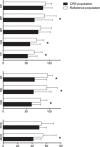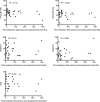Quality of life and mood assessment in conservatively treated cavernous malformation-related epilepsy
- PMID: 35470577
- PMCID: PMC9226805
- DOI: 10.1002/brb3.2595
Quality of life and mood assessment in conservatively treated cavernous malformation-related epilepsy
Abstract
Background: To estimate the quality of life, anxiety, depression, and illness perception in patients with medically treated cerebral cavernous malformation (CCM) and associated epilepsy.
Methods: Nonsurgically treated patients with CCM-related epilepsy (CRE) were included. Demographic, radiographic, and clinical features were assessed. All participants received established questionnaires (short-form 36 health survey, SF-36; hospital anxiety and depression score, HADS-A/D; visual analogue scale score, VAS) assessing the functional and psychosocial burden of disease. To some extent, calculated values were compared with reference values from population-based studies. Test results were related to seizure control.
Results: A total of 37 patients were included. Mean age was 45.8 ± 14.4 years, and 54.1% were female. Diagnosis of CRE was significantly associated with attenuated quality of life and increased level of anxiety, affecting physical and psychosocial dimensions. The assessment of illness perception identified considerable burden. HADS was significantly associated with VAS and SF-36 component scores. Efficacy of antiepileptic medication had no restoring impact on quality of life, anxiety, depression, or illness perception.
Conclusions: CRE negatively influences quality of life and mood, independent of seizure control due to antiepileptic medication. Screening for functional and psychosocial deficits in clinical practice might be useful for assessing individual burden and allocating surgical or drug treatment.
Keywords: anxiety; cerebral cavernous malformation; depression; epilepsy; quality of life.
© 2022 The Authors. Brain and Behavior published by Wiley Periodicals LLC.
Conflict of interest statement
The authors have declared that no competing interest.
Figures



Similar articles
-
Effect of lacosamide on depression and anxiety symptoms in patients with focal refractory epilepsy: A prospective multicenter study.Epilepsy Behav. 2018 Feb;79:87-92. doi: 10.1016/j.yebeh.2017.10.032. Epub 2017 Dec 16. Epilepsy Behav. 2018. PMID: 29253680
-
Epilepsy in patients with primary brain tumors: The impact on mood, cognition, and HRQOL.Epilepsy Behav. 2015 Jul;48:88-95. doi: 10.1016/j.yebeh.2015.03.016. Epub 2015 Jun 29. Epilepsy Behav. 2015. PMID: 26136184
-
Health-related quality of life in patients with untreated cavernous malformations of the central nervous system.Eur J Neurol. 2021 Feb;28(2):491-499. doi: 10.1111/ene.14546. Epub 2020 Oct 24. Eur J Neurol. 2021. PMID: 32961598
-
Depression and epilepsy, pain and psychogenic non-epileptic seizures: clinical and therapeutic perspectives.Epilepsy Behav. 2012 Jun;24(2):169-81. doi: 10.1016/j.yebeh.2012.01.008. Epilepsy Behav. 2012. PMID: 22632407 Review.
-
Cavernoma-related epilepsy: review and recommendations for management--report of the Surgical Task Force of the ILAE Commission on Therapeutic Strategies.Epilepsia. 2013 Dec;54(12):2025-35. doi: 10.1111/epi.12402. Epub 2013 Oct 17. Epilepsia. 2013. PMID: 24134485 Review.
Cited by
-
Safety, Tolerability, and Pharmacokinetics of NRL-1049, a Rho-Associated Kinase Inhibitor, in Healthy Volunteers: A Phase 1, First-in-Human, Single-Ascending Dose, Randomized, Placebo-Controlled Trial.CNS Drugs. 2025 Sep;39(9):865-877. doi: 10.1007/s40263-025-01198-0. Epub 2025 Jul 8. CNS Drugs. 2025. PMID: 40627117 Free PMC article. Clinical Trial.
-
Cavernous Malformations of the Central Nervous System: A Comprehensive Review of Pathophysiology, Diagnosis, and Management.Cureus. 2024 Aug 23;16(8):e67591. doi: 10.7759/cureus.67591. eCollection 2024 Aug. Cureus. 2024. PMID: 39310452 Free PMC article. Review.
-
Patient-reported outcome measures in patients with familial cerebral cavernous malformations: results from the Treat_CCM trial.Front Neurol. 2024 Feb 14;15:1338941. doi: 10.3389/fneur.2024.1338941. eCollection 2024. Front Neurol. 2024. PMID: 38419711 Free PMC article.
-
Cavernous malformations of the central nervous system: An international consensus statement.Brain Spine. 2023 Nov 10;3:102707. doi: 10.1016/j.bas.2023.102707. eCollection 2023. Brain Spine. 2023. PMID: 38020995 Free PMC article.
-
Patient-reported outcomes in conservatively managed cerebral cavernous malformations.J Neurol. 2024 Dec 12;272(1):12. doi: 10.1007/s00415-024-12805-3. J Neurol. 2024. PMID: 39666180
References
-
- Al‐Shahi Salman, R. , Berg, M. J. , Morrison, L. , & Awad, I. A. (2008). Hemorrhage from cavernous malformations of the brain: Definition and reporting standards. Angioma Alliance Scientific Advisory Board. Stroke; A Journal of Cerebral Circulation, 39, 3222–3230. - PubMed
-
- Al‐Shahi Salman, R. , Kitchen, N. , Thomson, J. , Ganesan, V. , Mallucci, C. , & Radatz, M. (2016). Top ten research priorities for brain and spine cavernous malformations. Lancet Neurology, 15, 354–355. - PubMed
-
- Al‐Shahi Salman, R. , Hall, J. M. , Horne, M. A. , Moultrie, F. , Josephson, C. B. , Bhattacharya, J. J. , Counsell, C. E. , Murray, G. D. , Papanastassiou, V. , Ritchie, V. , Roberts, R. C. , Sellar, R. J. , & Warlow, C. P. (2012). Untreated clinical course of cerebral cavernous malformations: A prospective, population‐based cohort study. Lancet Neurology, 11, 217–224. - PMC - PubMed
-
- Bicalho, V. C. , Bergmann, A. , Domingues, F. , Frossard, J. T. , & de Souza, J. (2017). Cerebral cavernous malformations: patient‐reported outcome validates conservative management. Cerebrovascular Diseases, 44, 313–319. - PubMed
MeSH terms
Substances
LinkOut - more resources
Full Text Sources
Medical

